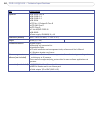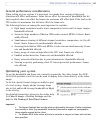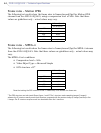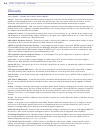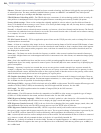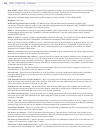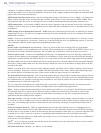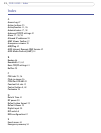
68
AXIS 241Q/241S - Glossary
Motion JPEG - Motion JPEG is a simple compression/decompression technique for network video. Latency is low and image
quality is guaranteed, regardless of movement or complexity of the image. Image quality is controlled by adjusting the
compression level, which in turn provides control over the file size, and thereby the bit rate.
High-quality individual images from the Motion JPEG stream are easily extracted. See also JPEG and GIF.
Megapixel - See Pixel.
MPEG (Moving Picture Experts Group) - The Moving Picture Experts Group develops standards for digital video
compression. It operates under the auspices of the International Organization for Standardization (ISO). The MPEG standards
are an evolving series, each designed for a different purpose.
MPEG-2 - The designation for a group of video coding standards, and is typically used to encode video for broadcast signals,
including digital satellite and Cable TV. MPEG-2, with some modifications, is also the coding format used by standard
commercial DVD movies.
MPEG-4 - MPEG-4 is a group of video coding standards and related technology. The primary uses for the MPEG-4 standard
are web (streaming media) and CD distribution, conversational (videophone), and broadcast television.
Most of the features included in MPEG-4 are left to individual developers to decide whether to implement them or not. This
means that there are probably no complete implementations of the entire MPEG-4 set of standards. To deal with this, the
standard includes the concept of "profiles" and "levels", allowing a specific set of capabilities to be defined in a manner
appropriate for a subset of applications.
Multicast - Bandwidth-conserving technology that reduces bandwidth usage by simultaneously delivering a single stream of
information to multiple network recipients. See also Unicast.
Network camera (Network video camera) - A network camera is a camera and computer combined in one intelligent unit. It
captures and sends live video directly over an IP network such as a LAN, intranet or the Internet. Users can view and/or
manage the camera using a standard web browser or application software from any local or remote computer on a network.
The camera allows multiple authorized viewers from different locations to simultaneously access images. A network camera
is sometimes known as an IP camera.
Network connectivity - The physical (wired or wireless) and logical (protocol) connection of a computer network or an
individual device to a network, such as the Internet or a LAN.
Network video - Network video (often referred to as IP-Surveillance for specific applications within security surveillance
and remote monitoring) is a system that gives users the ability to monitor and record video over an IP network
(LAN/WAN/Internet).
NTSC (National Television System Committee) - NTSC is an analog color encoding system used in television systems in
Japan, the United States and other parts of the Americas. NTSC defines the video signal using 525 TV lines per frame, at a
refresh rate equal to 30 frames per second. See also PAL.
NVR (Network Video Recorder) - A dedicated Network Video Recorder (NVR) can be used to gather data streams from
remote network cameras and video servers and store them on a hard disk. An NVR can be a standard networked PC, or a
dedicated video recording hard disk server with its own software application.
PAL (Phase Alternating Line) - PAL is an analog color encoding system used in television systems in Europe and in many
other parts of the world. PAL defines the video signal using 625 TV lines per frame, at a refresh rate equal to 25 frames per
second. See also NTSC.
Ping - Ping is a basic network program used diagnostically to check the status of a network host or device. Ping can be used
to see if a particular network address (IP address or host name) is occupied or not, or if the host at that address is responding
normally. Ping can be run from e.g. the Windows Command prompt or the command line in Unix.
Pixel (Picture Element) - A pixel is one of the many tiny dots that make up a digital image. The color and intensity of each
pixel represents a tiny area of the complete image.
PoE (Power over Ethernet) - Power over Ethernet provides power to a network device via the same cable as used for the
network connection. This is very useful for IP-Surveillance and remote monitoring applications in places where it may be too
impractical or expensive to power the device from a power outlet.
PPP (Point-to-Point Protocol) - A protocol that uses a serial interface for communication between two network devices. For
example, a PC connected by a phone line to a server.
PPTP (Point-to-Point Tunneling Protocol) - A protocol (set of communication rules) that allows corporations to extend their
own corporate network through private "tunnels" over the public Internet. In this way a corporation can effectively use a



